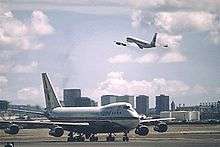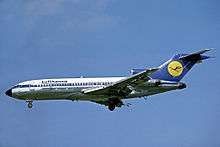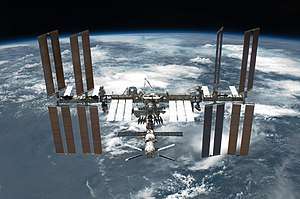Boeing
 | |
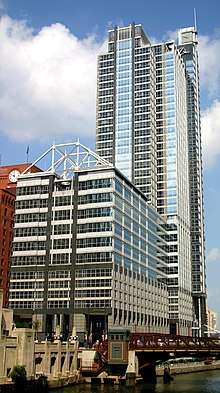 | |
| Public | |
| Traded as | |
| Industry | |
| Founded |
July 15, 1916 (as Pacific Aero Products Co.) Seattle, Washington, U.S.[1] |
| Founder | William Boeing |
| Headquarters | Chicago, Illinois, U.S.[2] |
Area served | Worldwide[1](p1) |
Key people |
Dennis Muilenburg (Chairman, President & CEO) |
| Products |
|
Production output | |
| Services |
|
| Revenue |
|
|
| |
|
| |
| Total assets |
|
| Total equity |
|
Number of employees | 141,322 (January 1, 2018)[4] |
| Divisions |
Boeing Commercial Airplanes Boeing Defense, Space & Security Boeing Capital Engineering, Operations & Technology Boeing Shared Services Group[1] |
| Subsidiaries |
|
| Website |
boeing |
The Boeing Company (/ˈboʊ.ɪŋ/) is an American multinational corporation that designs, manufactures, and sells airplanes, rotorcraft, rockets, satellites, and missiles worldwide. The company also provides leasing and product support services. Boeing is among the largest global aircraft manufacturers; it is the second-largest defense contractor in the world based on 2015 revenue,[5] and is the largest exporter in the United States by dollar value.[6][7] Boeing stock is included in the Dow Jones Industrial Average.
Boeing was founded by William Boeing on July 15, 1916.[8] The present corporation is the result of merger of Boeing with McDonnell Douglas on August 1, 1997. Former Boeing's chair and CEO Philip M. Condit continued as the chair and CEO of the new Boeing, while Harry Stonecipher, former CEO of McDonnell Douglas, became the president and chief operating officer of the newly merged company.[8]
The Boeing Company has its corporate headquarters in Chicago, Illinois. The company is led by President and CEO Dennis Muilenburg.[9][10][11] Boeing is organized into five primary divisions: Boeing Commercial Airplanes (BCA); Boeing Defense, Space & Security (BDS); Engineering, Operations & Technology; Boeing Capital; and Boeing Shared Services Group. In 2016, Boeing recorded $94.6 billion in sales, ranked 24th on the Fortune magazine "Fortune 500" list (2017),[12] ranked 61st on the "Fortune Global 500" list (2017), and ranked 25th on the "World's Most Admired Companies" list (2018).[13]
History
Before 1930
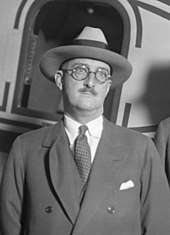
In March 1910, William E. Boeing bought Heath's shipyard in Seattle on the Duwamish River, which later became his first airplane factory.[14] Boeing was incorporated in Seattle by William Boeing, on July 15, 1916, as "Pacific Aero Products Co".[8] Boeing was later incorporated in Delaware; the original Certificate of Incorporation was filed with the Secretary of State of Delaware on July 19, 1934. Boeing, who studied at Yale University, worked initially in the timber industry, where he became wealthy and learned about wooden structures. This knowledge proved invaluable in his subsequent design and assembly of airplanes. The company stayed in Seattle to take advantage of the local supply of spruce wood.[15]
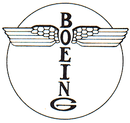
One of the two "B&W" seaplanes built with the assistance of George Conrad Westervelt, a U.S. Navy engineer, took its maiden flight on June 15, 1916. Boeing and Westervelt decided to build the B&W seaplane after having flown in a Curtiss aircraft. Boeing bought a Glenn Martin "Flying Birdcage" seaplane (so called because of all the guy-wires holding it together) and was taught to fly by Glenn Martin himself. Boeing soon crashed the Birdcage and when Martin informed Boeing that replacement parts would not become available for months, Boeing realized he could build his own plane in that amount of time. He and his friend Cdr. G.C. Westervelt agreed to build a better airplane and soon produced the B&W Seaplane.[16] This first Boeing airplane was assembled in a lakeside hangar located on the northeast shore of Seattle's Lake Union. Many of Boeing's early planes were seaplanes.
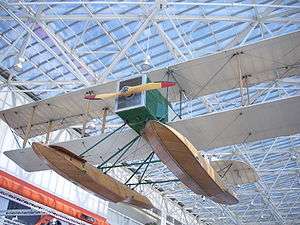
On April 6, 1917, the U.S. declared war on Germany and entered World War I. On May 9, 1917, the company became the "Boeing Airplane Company".[17] With the U.S. entering the war, Boeing knew that the U.S. Navy needed seaplanes for training. So Boeing shipped two new Model Cs to Pensacola, Florida, where the planes were flown for the Navy. The Navy liked the Model C and ordered 50 more.[18] The company moved its operations to a larger former shipbuilding facility known as Boeing Plant 1, located on the lower Duwamish River, Washington state.
When World War I ended in 1918, a large surplus of cheap, used military planes flooded the commercial airplane market, preventing aircraft companies from selling any new airplanes, driving many out of business. Others, including Boeing, started selling other products. Boeing built dressers, counters, and furniture, along with flat-bottom boats called Sea Sleds.[18]
In 1919 the Boeing B-1 flying boat made its first flight. It accommodated one pilot and two passengers and some mail. Over the course of eight years, it made international airmail flights from Seattle to Victoria, British Columbia.[19] On May 24, 1920, the Boeing Model 8 made its first flight. It was the first plane to fly over Mount Rainier.[20]
In 1923, Boeing entered competition against Curtiss to develop a pursuit fighter for the U.S. Army Air Service. Although Curtiss finished its design first and was awarded the contract, Boeing continued to develop its PW-9 fighter. That plane, along with the Boeing P-12/F4B fighter,[21] made Boeing a leading manufacturer of fighters over the course of the next decade.
In 1925, Boeing built its Model 40 mail plane for the U.S. government to use on airmail routes. In 1927, an improved version of this plane was built, the Model 40A which won the U.S. Post Office's contract to deliver mail between San Francisco and Chicago. The 40A also had a passenger cabin that accommodated two.[22]
That same year, Boeing created an airline named Boeing Air Transport, which merged a year later with Pacific Air Transport and the Boeing Airplane Company. The first airmail flight for the airline was on July 1, 1927.[22] The company changed its name to United Aircraft and Transport Corporation in 1929 and acquired Pratt & Whitney, Hamilton Standard Propeller Company, and Chance Vought. United Aircraft then purchased National Air Transport in 1930.
On July 27, 1928, the 12-passenger Boeing 80 biplane made its first flight. With three engines, it was Boeing's first plane built with the sole intention of being a passenger transport. An upgraded version, the 80A, carrying eighteen passengers, made its first flight in September 1929.[22]
1930s and 1940s
In 1930, the Monomail, a low-wing monoplane that carried mail, was built. Built entirely out of metal, it was very fast and aerodynamic, and had retractable landing gear. In fact, its design was so revolutionary that the engines and propellers of the time could not handle the plane. By the time controllable pitch propellers were developed, Boeing was building its Model 247 airliner. Two Monomails were built. The second one, the Model 221, had a 6-passenger cabin.[23][24]
In 1933, the Boeing 247 was introduced, the first truly modern airliner. The 247 was an all-metal low-wing monoplane that was much faster, safer, and easier to fly than other passenger aircraft. For example, it was the first twin engine passenger aircraft that could fly on one engine. In an era of unreliable engines, this vastly improved flight safety. Boeing built the first 59 aircraft exclusively for its own United Airlines subsidiary's operations. This badly hurt competing airlines, and was typical of the anti-competitive corporate behavior that the U.S. government sought to prohibit at the time.
The Air Mail Act of 1934 prohibited airlines and manufacturers from being under the same corporate umbrella, so the company split into three smaller companies – Boeing Airplane Company, United Airlines, and United Aircraft Corporation, the precursor to United Technologies. As a result, William Boeing sold off his shares and left Boeing. Clairmont "Claire" L. Egtvedt, who had become Boeing's president in 1933, became the chairman as well. He believed the company's future was in building bigger planes.[25][26] Work began in 1936 on Boeing Plant 2 to accommodate the production of larger modern aircraft.

_American_Overseas_1949-50.jpg)
Shortly after, an agreement with Pan American World Airways (Pan Am) was reached, to develop and build a commercial flying boat able to carry passengers on transoceanic routes. The first flight of the Boeing 314 Clipper was in June 1938. It was the largest civil aircraft of its time, with a capacity of 90 passengers on day flights, and of 40 passengers on night flights. One year later, the first regular passenger service from the U.S. to the UK was inaugurated. Subsequently, other routes were opened, so that soon Pan Am flew with the Boeing 314 to destinations all over the world.
In 1938, Boeing completed work on its Model 307 Stratoliner. This was the world's first pressurized-cabin transport aircraft, and it was capable of cruising at an altitude of 20,000 feet (6,100 m) – above most weather disturbances. It was based on the B-17, using the same wings, tail and engines.
During World War II, Boeing built a large number of B-17 and B-29 bombers. Boeing ranked twelfth among United States corporations in the value of wartime production contracts.[27] Many of the workers were women whose husbands had gone to war. In the beginning of March 1944, production had been scaled up in such a manner that over 350 planes were built each month. To prevent an attack from the air, the manufacturing plants had been covered with greenery and farmland items. During the war years the leading aircraft companies of the U.S. cooperated. The Boeing-designed B-17 bomber was assembled also by Lockheed Aircraft Corp. and Douglas Aircraft Co., while the B-29 was assembled also by Bell Aircraft Co. and by Glenn L. Martin Company.[28]
After the war, most orders of bombers were canceled and 70,000 people lost their jobs at Boeing. The company aimed to recover quickly by selling its Stratocruiser (the Model 377), a luxurious four-engine commercial airliner developed from the B-29. However, sales of this model were not as expected and Boeing had to seek other opportunities to overcome the situation. The company successfully sold military derivatives of the Stratocruiser, such as the C-97 adapted for troop transportation and the KC-97 for aerial refueling.
1950s

Boeing developed military jets such as the B-47 Stratojet[29] and B-52 Stratofortress bombers in the late-1940s and into the 1950s. During the early 1950s, Boeing used company funds to develop the 367–80 jet airliner demonstrator that led to the KC-135 Stratotanker and Boeing 707 jetliner. Some of these were built at Boeing's facilities in Wichita, Kansas, which existed from 1931 to 2014.
In the mid-1950s technology had advanced significantly, which gave Boeing the opportunity to develop and manufacture new products. One of the first was the guided short-range missile used to intercept enemy aircraft. By that time the Cold War had become a fact of life, and Boeing used its short-range missile technology to develop and build an intercontinental missile.
In 1958, Boeing began delivery of its 707, the United States' first commercial jet airliner, in response to the British De Havilland Comet, French Sud Aviation Caravelle and Soviet Tupolev Tu-104, which were the world's first generation of commercial jet aircraft. With the 707, a four-engine, 156-passenger airliner, the U.S. became a leader in commercial jet manufacturing. A few years later, Boeing added a second version of this aircraft, the Boeing 720, which was slightly faster and had a shorter range.
Boeing was a major producer of small turbine engines during the 1950s and 1960s. The engines represented one of the company's major efforts to expand its product base beyond military aircraft after World War II. Development on the gas turbine engine started in 1943 and Boeing's gas turbines were designated models 502 (T50), 520 (T60), 540, 551 and 553. Boeing built 2,461 engines before production ceased in April 1968. Many applications of the Boeing gas turbine engines were considered to be firsts, including the first turbine-powered helicopter and boat.[30]
1960s
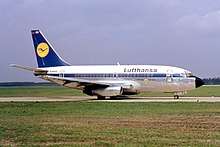
Vertol Aircraft Corporation was acquired by Boeing in 1960,[31] and was reorganized as Boeing's Vertol division. The twin-rotor CH-47 Chinook, produced by Vertol, took its first flight in 1961. This heavy-lift helicopter remains a work-horse vehicle to the present day. In 1964, Vertol also began production of the CH-46 Sea Knight.
In December 1960, Boeing announced the model 727 jetliner, which went into commercial service about three years later. Different passenger, freight and convertible freighter variants were developed for the 727. The 727 was the first commercial jetliner to reach 1,000 sales.[32]
On May 21, 1961, the company shortened its name to the current "Boeing Company".[33]
Boeing won a contract in 1961 to manufacture the S-IC stage of the Saturn V rocket, manufactured at the Michoud Assembly Facility in New Orleans, Louisiana.
In 1966, Boeing president William M. Allen asked Malcolm T. Stamper to spearhead production of the new 747 airliner on which the company's future was riding. This was a monumental engineering and management challenge, and included construction of the world's biggest factory in which to build the 747 at Everett, Washington, a plant which is the size of 40 football fields.[34]
In 1967, Boeing introduced another short- and medium-range airliner, the twin-engine 737. It has since become the best-selling commercial jet aircraft in aviation history.[35] Several versions have been developed, mainly to increase seating capacity and range. The 737 remains in production as of February 2018 with the latest 737 MAX series.
The roll-out ceremonies for the first 747-100 took place in 1968, at the massive new factory in Everett, about an hour's drive from Boeing's Seattle home. The aircraft made its first flight a year later. The first commercial flight occurred in 1970. The 747 has an intercontinental range and a larger seating capacity than Boeing's previous aircraft.
Boeing also developed hydrofoils in the 1960s. The screw-driven USS High Point (PCH-1) was an experimental submarine hunter. The patrol hydrofoil USS Tucumcari (PGH-2) was more successful. Only one was built, but it saw service in Vietnam and Europe before running aground in 1972. Its waterjet and fully submersed flying foils were the example for the later Pegasus-class patrol hydrofoils and the Model 929 Jetfoil ferries in the 1980s. The Tucumcari and later boats were produced in Renton. While the Navy hydrofoils were withdrawn from service in the late 1980s, the Boeing Jetfoils are still in service in Asia.
1970s
In the early 1970s Boeing suffered from the simultaneous decline in Vietnam War military spending, the slowing of the space program as Project Apollo neared completion, the recession of 1969–70,[36]:291 and the company's $2 billion debt as it built the new 747 airliner.[36]:303 Boeing did not receive any orders for more than a year. Its bet for the future, the 747, was delayed in production by three months because of problems with its Pratt & Whitney engines. Then in March 1971, Congress voted to discontinue funding for the development of the Boeing 2707 supersonic transport (SST), the US's answer to the British-French Concorde, forcing the end of the project.[37][38][39][40][41][42]
Commercial Airplane Group, by far the largest unit of Boeing, went from 83,700 employees in 1968 to 20,750 in 1971. Each unemployed Boeing employee cost at least one other job in the Seattle area, and unemployment rose to 14 percent, the highest in the United States. Housing vacancy rates rose to 16 percent from 1 percent in 1967. U-Haul dealerships ran out of trailers because so many people moved out. A billboard appeared near the airport:[36]:303–304
Will the last person
leaving SEATTLE -
Turn out the lights.[36]:303
In January 1970, the first 747, a four-engine long-range airliner, flew its first commercial flight with Pan American World Airways. The 747 changed the airline industry, providing much larger seating capacity than any other airliner in production. The company has delivered over 1,500 Boeing 747s. The 747 has undergone continuous improvements to keep it technologically up-to-date. Larger versions have also been developed by stretching the upper deck. The newest version of the 747, the 747-8, remains in production as of 2018.
Boeing launched three Jetfoil 929-100 hydrofoils that were acquired in 1975 for service in the Hawaiian Islands. When the service ended in 1979 the three hydrofoils were acquired by Far East Hydrofoil for service between Hong Kong and Macau.[43]
During the 1970s, Boeing also developed the US Standard Light Rail Vehicle, which has been used in San Francisco, Boston, and Morgantown, West Virginia.[44]
1980s
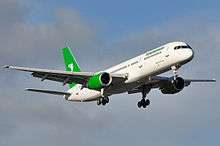

In 1983, the economic situation began to improve. Boeing assembled its 1,000th 737 passenger aircraft. During the following years, commercial aircraft and their military versions became the basic equipment of airlines and air forces. As passenger air traffic increased, competition was harder, mainly from Airbus, a European newcomer in commercial airliner manufacturing. Boeing had to offer new aircraft, and developed the single-aisle 757, the larger, twin-aisle 767, and upgraded versions of the 737. An important project of these years was the Space Shuttle, to which Boeing contributed with its experience in space rockets acquired during the Apollo era. Boeing participated also with other products in the space program, and was the first contractor for the International Space Station program.
During the decade several military projects went into production, including Boeing support of the B-2 stealth bomber. As part of an industry team led by Northrop, Boeing built the B-2's outer wing portion, aft center fuselage section, landing gear, fuel system, and weapons delivery system. At its peak in 1991, the B-2 was the largest military program at Boeing, employing about 10,000 people. The same year, the US's National Aeronautic Association awarded the B-2 design team the Collier Trophy for the greatest achievement in aerospace in America. The first B-2 rolled out of the bomber's final assembly facility in Palmdale, California, in November 1988 and it flew for the first time on July 17, 1989.[45]
The Avenger air defense system and a new generation of short-range missiles also went into production. During these years, Boeing was very active in upgrading existing military equipment and developing new ones. Boeing also contributed to wind power development with the experimental MOD-2 Wind Turbines for NASA and the United States Department of Energy, and the MOD-5B for Hawaii.[46]
1990s

Boeing was one of seven competing companies that bid for the Advanced Tactical Fighter. Boeing agreed to team with General Dynamics and Lockheed, so that all three companies would participate in the development if one of the three companies designs was selected. The Lockheed design was eventually selected and developed into the F-22 Raptor.[47]
In April 1994, Boeing introduced the most modern commercial jet aircraft at the time, the twin-engine 777, with a seating capacity of approximately 300 to 370 passengers in a typical three-class layout, in between the 767 and the 747. The longest range twin-engined aircraft in the world, the 777 was the first Boeing airliner to feature a "fly-by-wire" system and was conceived partly in response to the inroads being made by the European Airbus into Boeing's traditional market. This aircraft reached an important milestone by being the first airliner to be designed entirely by using computer-aided design (CAD) techniques.[48] The 777 was also the first airplane to be certified for 180 minute ETOPS at entry into service by the FAA.[49] Also in the mid-1990s, the company developed the revamped version of the 737, known as the 737 "Next-Generation", or 737NG. It has since become the fastest-selling version of the 737 in history, and on April 20, 2006 sales passed those of the "Classic 737", with a follow-up order for 79 aircraft from Southwest Airlines.
In 1995, Boeing chose to demolish the headquarters complex on East Marginal Way South instead of upgrading it to match new seismic standards. The headquarters were moved to an adjacent building and the facility was demolished in 1996.[50] In 1997, Boeing was headquartered on East Marginal Way South, by King County Airport, in Seattle.[51]
In 1996, Boeing acquired Rockwell's aerospace and defense units. The Rockwell business units became a subsidiary of Boeing, named Boeing North American, Inc. In August 1997, Boeing merged with McDonnell Douglas in a US$13 billion stock swap, with Boeing as the surviving company.[33] Following the merger, the McDonnell Douglas MD-95 was renamed the Boeing 717, and the production of the MD-11 trijet was limited to the freighter version. Boeing introduced a new corporate identity with completion of the merger, incorporating the Boeing logo type and a stylized version of the McDonnell Douglas symbol, which was derived from the Douglas Aircraft logo from the 1970s.
An aerospace analyst criticized the CEO and his deputy, Philip M. Condit and Harry Stonecipher, for thinking of their personal benefit first, and causing the problems to Boeing many years later. Instead of investing the huge cash reserve to build new airplanes, they initiated a program to buy back Boeing stock for more than US$10 billion.[52]
In May 1999, Boeing studied buying Embraer to encourage commonality between the E-Jets and the Boeing 717, but this was nixed by then president Harry Stonecipher. He preferred buying Bombardier Aerospace, but its owner, the Beaudoin family, asked for a price too high for Boeing which remembered its mid-1980s purchase of de Havilland Canada, losing a million dollars every day for three years before selling it to Bombardier in 1992.[53]
2000–2009
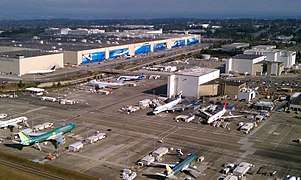
In January 2000, Boeing chose to expand its presence in another aerospace field of satellite communications by purchasing Hughes Electronics.[54] Hughes Space and Communications Company, which had pioneered the satellite communications field.
In September 2001, Boeing moved its corporate headquarters from Seattle to Chicago. Chicago, Dallas and Denver – vying to become the new home of the world's largest aerospace concern – all had offered packages of multimillion-dollar tax breaks.[55] Its offices are located in the Fulton River District just outside the Chicago Loop.[11]
On October 10, 2001, Boeing lost to its rival Lockheed Martin in the fierce competition for the multibillion-dollar Joint Strike Fighter contract. Boeing's entry, the X-32, was rejected in favor of Lockheed's X-35 entrant. Boeing continues to serve as the prime contractor on the International Space Station and has built several of the major components.
Boeing began development of the KC-767 aerial refueling tanker in the early 2000s. Italy and Japan ordered four KC-767s each. After development delays and FAA certification, Boeing delivered the tankers to Japan from 2008[56][57] with the second KC-767 following on March 5.[58] to 2010.[59] Italy received its four KC-767 during 2011.[60][61][62]
In 2004, Boeing ended production of the 757 after 1,050 aircraft were produced. More advanced, stretched versions of the 737 were beginning to compete against the 757, and the planned 787-3 was to fill much of the top end of the 757 market. Also that year, Boeing announced that the 717, the last civil aircraft to be designed by McDonnell Douglas, would cease production in 2006. The 767 was in danger of cancellation as well, with the 787 replacing it, but orders for the freighter version extended the program.
After several decades of success, Boeing lost ground to Airbus and subsequently lost its lead in the airliner market in 2003. Multiple Boeing projects were pursued and then canceled, notably the Sonic Cruiser, a proposed jetliner that would travel just under the speed of sound, cutting intercontinental travel times by as much as 20 percent. It was launched in 2001 along with a new advertising campaign to promote the company's new motto, "Forever New Frontiers", and to rehabilitate its image. However, the plane's fate was sealed by the changes in the commercial aviation market following the September 11 attacks and the subsequent weak economy and increase in fuel prices.
Subsequently, Boeing streamlined its production and turned its attention to a new model, the Boeing 787 Dreamliner, using much of the technology developed for the Sonic Cruiser, but in a more conventional aircraft designed for maximum efficiency. The company also launched new variants of its successful 737 and 777 models. The 787 proved to be a highly popular choice with airlines, and won a record number of pre-launch orders. With delays to Airbus' A380 program several airlines threatened to switch their A380 orders to Boeing's new 747 version, the 747-8.[63] Airbus's response to the 787, the A350, received a lukewarm response at first when it was announced as an improved version of the A330, and then gained significant orders when Airbus promised an entirely new design. The 787 program encountered delays, with the first flight not occurring until late 2009.[64]
After regulatory approval, Boeing formed a joint venture, United Launch Alliance with its competitor, Lockheed Martin, on December 1, 2006. The new venture is the largest provider of rocket launch services to the U.S. government.[65]
In 2005, Gary Scott, ex-Boeing executive and then head of Bombardier's CSeries program, suggested a collaboration on the upcoming CSeries, but an internal study assessed Embraer as the best partner for regional jets. The Brazilian government wanted to retain control and blocked an acquisition.[53]
On August 2, 2005, Boeing sold its Rocketdyne rocket engine division to Pratt & Whitney. On May 1, 2006, Boeing agreed to purchase Dallas, Texas-based Aviall, Inc. for $1.7 billion and retain $350 million in debt. Aviall, Inc. and its subsidiaries, Aviall Services, Inc. and ILS formed a wholly owned subsidiary of Boeing Commercial Aviation Services (BCAS).[66]
Realizing that increasing numbers of passengers have become reliant on their computers to stay in touch, Boeing introduced Connexion by Boeing, a satellite based Internet connectivity service that promised air travelers unprecedented access to the World Wide Web. The company debuted the product to journalists in 2005, receiving generally favorable reviews. However, facing competition from cheaper options, such as cellular networks, it proved too difficult to sell to most airlines. In August 2006, after a short and unsuccessful search for a buyer for the business, Boeing chose to discontinue the service.[67][68]
On August 18, 2007, NASA selected Boeing as the manufacturing contractor for the liquid-fueled upper stage of the Ares I rocket.[69] The stage, based on both Apollo-Saturn and Space Shuttle technologies, was to be constructed at NASA's Michoud Assembly Facility near New Orleans; Boeing constructed the S-IC stage of the Saturn V rocket at this site in the 1960s.
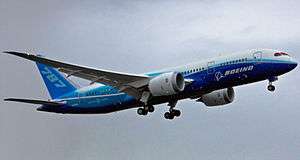
Boeing launched the 777 Freighter in May 2005 with an order from Air France. The freighter variant is based on the −200LR. Other customers include FedEx and Emirates. Boeing officially announced in November 2005 that it would produce a larger variant of the 747, the 747-8, in two versions, commencing with the Freighter version with firm orders for two cargo carriers. The second version, named the Intercontinental, is for passenger airlines. Both 747-8 versions feature a lengthened fuselage, new, advanced engines and wings, and the incorporation of other technologies developed for the 787.
Boeing also received the launch contract from the U.S. Navy for the P-8 Poseidon Multimission Maritime Aircraft, an anti-submarine warfare patrol aircraft. It has also received orders for the 737 AEW&C "Wedgetail" aircraft. The company has also introduced new extended range versions of the 737. These include the 737-700ER and 737-900ER. The 737-900ER is the latest and will extend the range of the 737–900 to a similar range as the successful 737–800 with the capability to fly more passengers, due to the addition of two extra emergency exits.
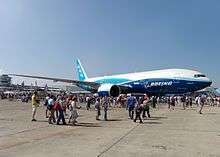
The 777-200LR Worldliner embarked on a well-received global demonstration tour in the second half of 2005, showing off its capacity to fly farther than any other commercial aircraft. On November 10, 2005, the 777-200LR set a world record for the longest non-stop flight. The plane, which departed from Hong Kong traveling to London, took a longer route, which included flying over the U.S. It flew 11,664 nautical miles (21,601 km) during its 22-hour 42-minute flight. It was flown by Pakistan International Airlines pilots and PIA was the first airline to fly the 777-200LR Worldliner.
On August 11, 2006, Boeing agreed to form a joint-venture with the large Russian titanium producer, VSMPO-Avisma for the machining of titanium forgings. The forgings will be used on the 787 program.[70] In December 2007, Boeing and VSMPO-Avisma created a joint venture, Ural Boeing Manufacturing, and signed a contract on titanium product deliveries until 2015, with Boeing planning to invest $27 billion in Russia over the next 30 years.[71]
In February 2011, Boeing received a contract for 179 KC-46 U.S. Air Force tankers at a value of $35 billion.[72] The KC-46 tankers are based on the KC-767.
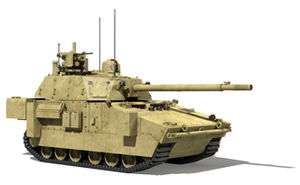
Boeing, along with Science Applications International Corporation (SAIC), were the prime contractors in the U.S. military's Future Combat Systems program.[73] The FCS program was canceled in June 2009 with all remaining systems swept into the BCT Modernization program.[74] Boeing works jointly with SAIC in the BCT Modernization program like the FCS program but the U.S. Army will play a greater role in creating baseline vehicles and will only contract others for accessories.
Defense Secretary Robert M. Gates' shift in defense spending to, "make tough choices about specific systems and defense priorities based solely on the national interest and then stick to those decisions over time"[75] hit Boeing especially hard, because of their heavy involvement with canceled Air Force projects.[76]
Unethical conduct
In May 2003, the U.S. Air Force announced it would lease 100 KC-767 tankers to replace the oldest 136 KC-135s. In November 2003, responding to critics who argued that the lease was more expensive than an outright purchase, the DoD announced a revised lease of 20 aircraft and purchase of 80. In December 2003, the Pentagon announced the project was to be frozen while an investigation of allegations of corruption by one of its former procurement staffers, Darleen Druyun (who began employment at Boeing in January) was begun. The fallout of this resulted in the resignation of Boeing CEO Philip M. Condit and the termination of CFO Michael M. Sears.[77] Harry Stonecipher, former McDonnell Douglas CEO and Boeing COO, replaced Condit on an interim basis. Druyun pleaded guilty to inflating the price of the contract to favor her future employer and to passing information on the competing Airbus A330 MRTT bid. In October 2004, she received a jail sentence for corruption.[78]
In March 2005, the Boeing board forced President and CEO Harry Stonecipher to resign. Boeing said an internal investigation revealed a "consensual" relationship between Stonecipher and a female executive that was "inconsistent with Boeing's Code of Conduct" and "would impair his ability to lead the company".[79] James A. Bell served as interim CEO (in addition to his normal duties as Boeing's CFO) until the appointment of Jim McNerney as the new Chairman, President, and CEO on June 30, 2005.
Industrial espionage
In June 2003, Lockheed Martin sued Boeing, alleging that the company had resorted to industrial espionage in 1998 to win the Evolved Expendable Launch Vehicle (EELV) competition. Lockheed Martin claimed that the former employee Kenneth Branch, who went to work for McDonnell Douglas and Boeing, passed nearly 30,000 pages of proprietary documents to his new employers. Lockheed Martin argued that these documents allowed Boeing to win 19 of the 28 tendered military satellite launches.[80][81]
In July 2003, Boeing was penalized, with the Pentagon stripping seven launches away from the company and awarding them to Lockheed Martin.[80] Furthermore, the company was forbidden to bid for rocket contracts for a twenty-month period, which expired in March 2005.[81] In early September 2005, it was reported that Boeing was negotiating a settlement with the U.S. Department of Justice in which it would pay up to $500 million to cover this and the Darleen Druyun scandal.[82]
1992 EU-US Agreement notes
Until the late 1970s, the U.S. had a near monopoly in the Large Civil Aircraft (LCA) sector.[83] The Airbus consortium (created in 1969) started competing effectively in the 1980s. At that stage the U.S. became concerned about the European competition and the alleged subsidies paid by the European governments for the developments of the early models of the Airbus family. This became a major issue of contention, as the European side was equally concerned by subsidies accruing to U.S. LCA manufacturers through NASA and Defense programs.
The EU and the U.S. started bilateral negotiations for the limitation of government subsidies to the LCA sector in the late 1980s. Negotiations were concluded in 1992 with the signing of the EC-US Agreement on Trade in Large Civil Aircraft which imposes disciplines on government support on both sides of the Atlantic which are significantly stricter than the relevant World Trade Organization (WTO) rules: Notably, the Agreement regulates in detail the forms and limits of government support, prescribes transparency obligations and commits the parties to avoiding trade disputes.[84]
Subsidy disputes
In 2004, the EU and the U.S. agreed to discuss a possible revision of the 1992 EU-US Agreement provided that this would cover all forms of subsidies including those used in the U.S., and in particular the subsidies for the Boeing 787; the first new aircraft to be launched by Boeing for 14 years. In October 2004 the U.S. began legal proceedings at the WTO by requesting WTO consultations on European launch investment to Airbus. The U.S. also unilaterally withdrew from the 1992 EU-US Agreement.[85] The U.S. claimed Airbus had violated a 1992 bilateral accord when it received what Boeing deemed "unfair" subsidies from several European governments. Airbus responded by filing a separate complaint, contesting that Boeing had also violated the accord when it received tax breaks from the U.S. Government. Moreover, the EU also complained that the investment subsidies from Japanese airlines violated the accord.
On January 11, 2005, Boeing and Airbus agreed that they would attempt to find a solution to the dispute outside of the WTO. However, in June 2005, Boeing and the United States government reopened the trade dispute with the WTO, claiming that Airbus had received illegal subsidies from European governments. Airbus has also responded to this claim against Boeing, reopening the dispute and also accusing Boeing of receiving subsidies from the U.S. Government.[86]
On September 15, 2010, the WTO ruled that Boeing had received billions of dollars in government subsidies.[87] Boeing responded by stating that the ruling was a fraction of the size of the ruling against Airbus and that it required few changes in its operations.[88] Boeing has received $8.7 billion in support from Washington state.[89]
Future concepts
In May 2006, four concept designs being examined by Boeing were outlined in The Seattle Times based on corporate internal documents. The research aims in two directions: low-cost airplanes, and environmental-friendly planes. Codenamed after the well-known Muppets, a design team known as the Green Team concentrated primarily on reducing fuel usage. All four designs illustrated rear-engine layouts.[90]
- "Fozzie" employs open rotors and offers a lower cruising speed.[90]
- "Beaker" has very thin, long wings, with the ability to partially fold-up to facilitate easier taxiing.
- "Kermit Kruiser" has forward swept wings over which are positioned its engines, with the aim of lowering noise below due to the reflection of the exhaust signature upward.[90]
- "Honeydew" with its delta wing design, resembles a marriage of the flying wing concept and the traditional tube fuselage.[90]
As with most concepts, these designs are only in the exploratory stage, intended to help Boeing evaluate the potentials of such radical technologies.[90]
Boeing recently patented its own force field technology, also known as the shock wave attenuation system, that would protect vehicles from shock waves generated by nearby explosions.[91] Boeing has yet to confirm when they plan to build and test the technology.[92]
The Boeing Yellowstone Project is the company's project to replace its entire civil aircraft portfolio with advanced technology aircraft. New technologies to be introduced include composite aerostructures, more electrical systems (reduction of hydraulic systems), and more fuel-efficient turbofan engines, such as the Pratt & Whitney PW1000G Geared Turbofan, General Electric GEnx, the CFM International LEAP56, and the Rolls-Royce Trent 1000. The term "Yellowstone" refers to the technologies, while "Y1" through "Y3" refer to the actual aircraft.
2010–2016
In summer 2010, Boeing acquired Fairfax, VA-based C4ISR and combat systems developer Argon ST to expand its C4ISR, cyber and intelligence capabilities.[93]
In 2011, Boeing was hesitating between re-engineing the 737 or developing an all-new small airplane for which Embraer could have been involved, but when the A320neo was launched with new engines, that precipitated the 737 MAX decision.[53] On November 17, Boeing received its largest provisional order for $21.7 billion at list prices from Indonesian LCC Lion Air for 201 737 MAX, 29 737-900ERs and 150 purchase rights, days after its previous order record of $18 billion for 50 777-300ER from Emirates.[94]

On January 5, 2012, Boeing announced it would close its facilities in Wichita, Kansas with 2,160 workers before 2014, more than 80 years after it was established, where it had employed as many as 40,000 people.[95][96]
In May 2013, Boeing announced it would cut 1,500 IT jobs in Seattle over the next three years through layoffs, attrition and mostly relocation to St. Louis and North Charleston, South Carolina − 600 jobs each.[97][98] In September, Boeing announced their Long Beach facility manufacturing the C-17 Globemaster III military transport would shut down.[99]
In January 2014, the company announced US$1.23 billion profits for Q4 2013, a 26% increase, due to higher demand for commercial aircraft.[100] The last plane to undergo maintenance in Boeing Wichita’s facility left in May 2014.[101] In September, NASA awarded contracts to Boeing and SpaceX for transporting astronauts to the International Space Station.[102]
In June 2015, Boeing announced that James McNerney would step down as CEO to be replaced by Boeing's COO, Dennis Muilenburg, on July 1, 2015.[9] The 279th and last C-17 was delivered in summer before closing the site, affecting 2,200 jobs.[99]
In February 2016, Boeing announced that Boeing President and CEO Dennis Muilenburg was elected the 10th Chairman of the Board, succeeding James McNerney.[103] In March, Boeing announced to cut 4,000 jobs from its commercial airplane division by mid-year.[104] On May 13, 2016, Boeing opened a $1 billion, 27-acre (11-hectare) factory in Washington state that will make carbon-composite wings for its 777X to be delivered by 2020.[105]
CSeries dumping petition
.jpg)
On 28 April 2016, Bombardier Aerospace sold 75 CSeries CS100 firmly plus 50 options to Delta Air Lines. On 27 April 2017, Boeing filed a petition for dumping them at $19.6m each, below their $33.2m production cost.
On 9 June 2017, the US International Trade Commission (USITC) found the US industry could be threatened. On 26 September, the US Department of Commerce (DoC) observed subsidies of 220% and will collect deposits based on these. It will add a 80% preliminary anti-dumping duty on top, resulting in a total duty of 300%. The DoC announced its final ruling, a total duty of 292%, on 20 December. On 10 January 2018, the Canadian government filed a complaint at the World Trade Organisation against the US.
On 26 January 2018, the USITC four commissioners unanimously determined the US industry is not threatened and no duty orders will be issued, overturning the imposed duties. The Commission public report was made available by February 2018. On March 22, Boeing declined to appeal the ruling.
Since 2017
In May 2017 Saudi Arabia bought 48 CH-47F Chinooks worth $3.51 billion with related equipment, training and support.[106]
In October 2017, Boeing announced plans to acquire Aurora Flight Sciences to expand its capabilities to develop autonomous, electric-powered and long-flight-duration aircraft for its commercial and military businesses, pending regulatory approval.[107][108]
In 2017, Boeing won 912 net orders for $134.8 billion at list prices including 745 737s, 94 787s and 60 777s, and delivered 763 airliners including 529 737s, 136 787s and 74 777s.[109]
In January 2018, a joint venture was formed by auto seat maker Adient (50.01%) and Boeing (49.99%) to develop and manufacture airliner seats for new installations or retrofit, a $4.5 billion market in 2017 which will grow to $6 billion by 2026, to be based in Kaiserslautern near Frankfurt and distributed by Boeing subsidiary Aviall, with its customer service center in Seattle.[110]
On June 4, 2018, Boeing and Safran announced a 50-50 partnership to design, build and service APUs after regulatory and antitrust clearance in the second half of 2018.[111] This could threaten the dominance of Honeywell and United Technologies in the APU market.[112]
At a June 2018 AIAA conference, Boeing unveiled a hypersonic transport project.[113]
In September 2018, Boeing signed a deal with the Pentagon worth up to $2.4 billion to provide helicopters for protecting nuclear-missile bases.[114] Boeing enhanced its space business by acquiring the satellite company Millennium Space System in September 2018.[115]
Boeing-Embraer joint venture
On July 5, 2018, a joint venture was announced for Embraer's airliners.[116] This is seen as a reaction to Airbus acquiring a majority of the competing Bombardier CSeries on October 16, 2017.[117]
Environment
Environmental record
In 2006, the UCLA Center for Environmental Risk Reduction released a study showing that Boeing's Santa Susana Field Laboratory, in the Simi Hills of eastern Ventura County in Southern California, had been contaminated with toxic and radioactive waste. The study found that air, soil, groundwater, and surface water at the site all contained radionuclides, toxic metals, and dioxins; air and water additionally contained perchlorate, TCE, and hydrazines, while water showed the presence of PCBs as well.[118] Clean up studies and lawsuits are in progress.[119][120]
Jet biofuels
The airline industry is responsible for about 11 percent of greenhouse gases emitted by the U.S. transportation sector.[121] Aviation's share of the greenhouse gas emissions is poised to grow, as air travel increases and ground vehicles use more alternative fuels like ethanol and biodiesel.[121] Boeing estimates that biofuels could reduce flight-related greenhouse-gas emissions by 60 to 80 percent.[121] The solution blends algae fuels with existing jet fuel.[121]
Boeing executives said the company is informally collaborating with leading Brazilian biofuels maker Tecbio, Aquaflow Bionomic of New Zealand and other fuel developers around the world. So far, Boeing has tested six fuels from these companies, and will probably have gone through 20 fuels "by the time we're done evaluating them".[121] Boeing was also joining other aviation-related members in the Algal Biomass Organization (ABO) on June 2008.[122]
Air New Zealand and Boeing are researching the jatropha plant to see if it is a sustainable alternative to conventional fuel.[123] A two-hour test flight using a 50–50 mixture of the new biofuel with Jet A-1 in the number one position Rolls Royce RB-211 engine of 747-400 ZK-NBS, was successfully completed on December 30, 2008. The engine was then removed to be scrutinised and studied to identify any differences between the Jatropha blend and regular Jet A1. No effects to performances were found.
On August 31, 2010, Boeing worked with the U.S. Air Force to test the Boeing C-17 running on 50 percent JP-8, 25 percent Hydro-treated Renewable Jet fuel and 25 percent of a Fischer–Tropsch fuel with successful results.[124]
Electric propulsion
For NASA's N+3 future airliner program, Boeing has determined that hybrid electric engine technology is by far the best choice for its subsonic design. Hybrid electric propulsion has the potential to shorten takeoff distance and reduce noise.[125]
Political contributions, federal contracts, advocacy
In both 2008 and 2009, Boeing was second on the list of Top 100 US Federal Contractors, with contracts totalling $22 billion and $23 billion respectively.[126][127] Since 1995, the company has agreed to pay $1.6 billion to settle 39 instances of misconduct, including $615 million in 2006 in relation to illegal hiring of government officials and improper use of proprietary information.[128][129]
Boeing secured the highest ever tax breaks at the state level in 2013.[130]
Boeing's 2010 lobbying expenditure by the third quarter was $13.2 million (2009 total: $16.9 million).[131][132] In the 2008 presidential election, Barack Obama "was by far the biggest recipient of campaign contributions from Boeing employees and executives, hauling in $197,000 – five times as much as John McCain, and more than the top eight Republicans combined".[133]
Boeing has a corporate citizenship program centered on charitable contributions in five areas: education, health, human services, environment, the arts, culture, and civic engagement.[134] In 2011, Boeing spent $147.3 million in these areas through charitable grants and business sponsorships.[135] In February 2012, Boeing Global Corporate Citizenship partnered with the Insight Labs to develop a new model for foundations to more effectively lead the sector that they serve.[136]
The company is a member of the U.S. Global Leadership Coalition, a Washington D.C.-based coalition of over 400 major companies and NGOs that advocates for a larger International Affairs Budget, which funds American diplomatic and development efforts abroad.[137] A series of U.S. diplomatic cables show how U.S. diplomats and senior politicians intervene on behalf of Boeing to help boost the company's sales.[138]
In 2007 and 2008, the company benefited from over $10 billion of long-term loan guarantees, helping finance the purchase of their commercial aircraft in countries including Brazil, Canada, Ireland and the United Arab Emirates, from the Export-Import Bank of the United States, some 65 percent of the total loan guarantees the bank made in the period.[139]
In December 2011, the non-partisan organization Public Campaign criticized Boeing for spending $52.29 million on lobbying and not paying taxes during 2008–2010, instead getting $178 million in tax rebates, despite making a profit of $9.7 billion, laying off 14,862 workers since 2008, and increasing executive pay by 31 percent to $41.9 million in 2010 for its top five executives.[140]
Divisions
The two largest divisions are Boeing Commercial Airplanes and Boeing Defense, Space & Security (BDS).[141]
- Boeing Capital
- Boeing Commercial Airplanes (BCA)
- Boeing Defense, Space & Security (BDS)
- Engineering, Test & Technology
- Boeing Research & Technology
- Boeing Test & Evaluation
- Intellectual Property Management
- Information Technology
- Environment, Health, and Safety[141]
- Boeing Shared Services Group
- Boeing Realty
- Boeing Travel Management Company
- Boeing Supplier Management
Employment numbers
The company's employment count is listed on its website below.
|
|
Approximately 1.5 percent of Boeing employees are in the Technical Fellowship program, a program through which Boeing's top engineers and scientists set technical direction for the company.[143] The average salary at Boeing is $76,784, reported by former employees.[144]
Corporate governance
Board of directors
Chief executive officer
|
Chairman of the board
President
|
See also
References
- 1 2 3 4 "The Boeing Company 2012 Form 10-K Annual Report, p. 6". Retrieved October 1, 2013.
- 1 2 3 4 5 6 "Boeing FY2017".
- 1 2 3 . Yahoo, 2017
- ↑ "Employment Data". Boeing
- ↑ "Top 100 for 2016" (based on 2015 data). Defense News.
- ↑ "Boeing says it's flying high despite recession". USA Today, March 27, 2009.
- ↑ "About". Boeing.com, July 2014.
- 1 2 3 "Boeing history chronology" (PDF). Boeing.
- 1 2 "Boeing Names Muilenburg Chief Executive Officer" (Press release). Boeing. June 23, 2015.
- ↑ Jon Ostrower (June 24, 2015). "Boeing Names Muilenburg CEO, Succeeding McNerney". WSJ.
- 1 2 "Contact Us." Boeing. Retrieved on May 12, 2009.
- ↑ "Boeing". Fortune. Retrieved June 30, 2017.
- ↑ "Boeing". Fortune. Retrieved June 30, 2017.
- ↑ "History". Boeing. Archived from the original on October 17, 2014. Retrieved May 21, 2011.
- ↑ Howe, Sam (October 2, 2010). "The tale of Boeing's high-risk flight into the jet age". The Seattle Times. Retrieved May 21, 2011.
- ↑ Boeing History Narrative – Beginnings – Biplanes by the Sea Archived November 20, 2010, at the Wayback Machine. Retrieved November 4, 2010.
- ↑ "Biography of William E. Boeing" (PDF). Boeing.
- 1 2 "Boeing History: Beginnings – World War I". Boeing. Retrieved November 4, 2010.
- ↑ "Products – Boeing B-1 Seaplane", History, Boeing, retrieved November 5, 2010 .
- ↑ "Beginnings… Growing Pains". History. Boeing. Retrieved November 5, 2010.
- ↑ Boeing P-12/F4B Fighter Archived November 20, 2010, at the Wayback Machine., retrieved November 5, 2010.
- 1 2 3 Boeing History—Beginnings... Mail and Boa abroad Archived November 20, 2010, at the Wayback Machine. Retrieved November 5, 2010.
- ↑ "Boeing History-Early Years...Metal Monomail". Boeing. August 5, 2005. Retrieved May 21, 2011.
- ↑ "Boeing History-Products- Monomail". Boeing. May 6, 1930. Retrieved May 21, 2011.
- ↑ "Boeing History". Boeing.
- ↑ Herman, Arthur. Freedom's Forge: How American Business Produced Victory in World War II, pp. 291–3, 36–7, 332, Random House, New York, NY. ISBN 978-1-4000-6964-4.
- ↑ Peck, Merton J. & Scherer, Frederic M. The Weapons Acquisition Process: An Economic Analysis (1962) Harvard Business School p.619
- ↑ Herman, Arthur. Freedom's Forge: How American Business Produced Victory in World War II, pp. 118, 297–8, Random House, New York, NY. ISBN 978-1-4000-6964-4.
- ↑ Mark Natola, ed. (2002). Boeing B-47 Stratojet. Schiffer Publishing Ltd. pp. 17–25. ISBN 0764316702.
- ↑ "History > Products > Model 502 gas turbine engine". Boeing.
- ↑ "Boeing History 1957–1970". Boeing. Retrieved May 21, 2011.
- ↑ "Boeing: Historical Snapshot". Boeing. Boeing. Retrieved September 23, 2016.
- 1 2 "The Boeing Log Book", various volumes, published by Boeing Historical Archives.
- ↑ Boyer, Tom (June 17, 2005). "Boeing legend Malcolm Stamper dies". The Seattle Times.
- ↑ Wyse, Beverley. "Vice President and General Manager, Next-Generation 737 Program". Boeing. Retrieved September 28, 2016.
- 1 2 3 4 Heppenheimer, T.A. (1998). The Space Shuttle Decision. NASA.
- ↑ "Senators reject more funds for transport plane". The Bulletin. (Bend, Oregon). UPI. March 24, 1971. p. 1.
- ↑ "SST funds denied". Eugene Register-Guard. (Oregon). Associated Press. March 24, 1971. p. 1.
- ↑ "Boeing will lay off 7,000 workers with disbandment of SST program". Spokesman-Review. (Spokane, Washington). Associated Press. March 26, 1971. p. 1.
- ↑ "SST supporters see little chance of reviving plan". Eugene Register-Guard. (Oregon). Associated Press. March 25, 1971. p. 1.
- ↑ "Boeing workers hardest hit by vote". The Bulletin. (Bend, Oregon). UPI. March 25, 1971. p. 1.
- ↑ "Supersonic Transport". Boeing. Retrieved July 9, 2017.
- ↑ "Classic Fast Ferries" (PDF). Retrieved August 14, 2010.
- ↑ "Please Help Us Preserve Boeing-Vertol Standard Light Rail Vehicle No. 3424 from Boston" (PDF). Seashore Trolley Museum. Seashore Trolley Museum. Archived from the original (PDF) on June 29, 2016. Retrieved September 23, 2016.
- ↑ "History – Products – B-2 Spirit". Boeing. Retrieved August 14, 2010.
- ↑ "MOD-2/MOD-5B Wind Turbines". Boeing. Retrieved June 30, 2009.
- ↑ Miller, Jay. Lockheed Martin F/A-22 Raptor, Stealth Fighter. Aerofax, 2005. ISBN 1-85780-158-X.
- ↑ Norris, Guy and Mark Wagner. Boeing 777: The Technological Marvel. Minneapolis, Minnesota: Zenith Imprint, 2001. ISBN 0-7603-0890-X.
- ↑ Pandey, Mohan (2010). How Boeing Defied the Airbus Challenge. Createspace. p. 86. ISBN 978-1-4505-0113-2.
- ↑ "Boeing to Raze Company Headquarters Building; Will Relocate to Adjacent Building" August 4, 1995.
- ↑ "Revises meeting arrangements and map for the Executive committee Meeting" (PDF). Gas Industry Standards Board. April 30, 1999. Retrieved May 13, 2009.
- ↑ MISSMANAGEMENT [sic]: Himmel, hilf!, DIE ZEIT, September 20, 2011 (de). Means: mismanagement, heaven help!
- 1 2 3 Dominic Gates (January 11, 2018). "Boeing's bid to buy Embraer could see Brazilian engineers work on the 797". The Seattle Times.
- ↑ "$3.75 Billion Boeing-Hughes Satellite Deal Expected". The New York Times. January 13, 2000.
- ↑ Pae, Peter (May 10, 2001). "Boeing Expected to Reveal New Home". Los Angeles Times. Retrieved February 9, 2009.
- ↑ "Boeing Delivers First KC-767 Tanker to Japan" Archived March 5, 2008, at the Wayback Machine.. Boeing, February 19, 2008.
- ↑ Capaccio, Tony, and Toko Sekiguchi, "Boeing Delay On Italy, Japan Tankers May Harm Bid For U.S. Work". Bloomberg, August 12, 2008.
- ↑ "Boeing Delivers 2nd KC-767 Tanker to Japan". Boeing, March 5, 2008.
- ↑ "Boeing Delivers 4th KC-767 Tanker to Japan Ministry of Defense". Boeing, January 12, 2010.
- ↑ Kington, Tom. "Italian Air Force Receives 1st Tanker From Boeing". Defense News, January 27, 2011.
- ↑ Kington, Tom."Italy Enters First 2 Boeing Tankers Into Service" Archived January 21, 2013, at Archive.is. Defense News, May 17, 2011.
- ↑ . Boeing
- ↑ Robertson, David (October 4, 2006). "Airbus will lose €4.8bn because of A380 delays". The Times. London.
- ↑ "Boeing 787 first flight announced". BBC News Online, August 27, 2009.
- ↑ "Boeing and Lockheed Martin Complete United Launch Alliance Transaction (news release)". The Boeing Company. December 1, 2006. Retrieved January 28, 2007.
- ↑ "Concludes Purchase of Aviall, Inc".
- ↑ "Boeing exits in-flight broadband". BBC News Online. August 17, 2006. Retrieved January 28, 2007.
- ↑ "Boeing to Discontinue Connexion by Boeing Service (news release)". The Boeing Company. August 17, 2006. Retrieved January 28, 2007.
- ↑ Davis, Daniel. "NASA Ares I Crew Launch Vehicle Upper Stage Overview" (PDF). National Aeronautic and Space Administration. Retrieved September 23, 2016.
- ↑ "Boeing and VSMPO-AVISMA Announce Titanium Agreement", Boeing, August 11, 2006.
- ↑ (in Russian) Корпорация ВСМПО-АВИСМА
- ↑ Donna Cassata, Lolita C. Baldor (February 24, 2011). "Boeing gets $35 billion Air Force tanker order". Associated Press. Retrieved February 26, 2011.
- ↑ Klein, Alec (December 7, 2007). "The Army's $200 billion Makeover". The Washington Post. Retrieved April 26, 2010.
- ↑ "Future Combat System (FCS) Program to Army Brigade Combat Team Modernization". U.S. DoD, June 23, 2009.
- ↑ Drew, Christopher (April 6, 2009). "Military Budget Reflects a Shift in U.S. Strategy". The New York Times. Retrieved May 21, 2011.
- ↑ "Pentagon budget cuts slam Boeing, raise stakes on tanker win". Blog.seattlepi.com. April 8, 2009. Retrieved June 7, 2011.
- ↑ "Ex-Boeing CFO Pleads Guilty in Druyun Case", The Washington Post, November 16, 2004.
- ↑ Ex-Air Force Official Gets Prison Time. The Washington Post. Retrieved on August 16, 2013.
- ↑ "Boeing CEO Stonecipher Resigns press release". Comspacewatch.com. Retrieved May 21, 2011.
- 1 2 Fleischauer, Eric (January 23, 2005). "Anatomy of a corporate espionage scandal". The Decatur Daily. Decatur, Alabama. Retrieved March 31, 2013.
- 1 2 Bowermaster, David (January 9, 2005). "Boeing probe intensifies over secret Lockheed papers". The Seattle Times. Seattle. Retrieved March 31, 2013.
- ↑ "Boeing, DOJ may reach settlement". St. Louis Business Journal. Bizjournals.com. September 9, 2005. Retrieved May 21, 2011.
- ↑ Newquist, Don E. "Global Competitiveness of U.S. Advanced-Technology Manufacturing Industries: Large Civil Aircraft" (PDF). U.S. International Trade Commission. Retrieved January 16, 2013.
- ↑ "Top margin 1" (PDF). Retrieved May 21, 2011.
- ↑ "EU resumes WTO case against Boeing" (PDF). European Trade Commission, Commissioner Mandelson. May 31, 2005. Archived from the original (PDF) on February 16, 2008. Retrieved October 26, 2015.
- ↑ "Industrial Subsidies and the Politics of World Trade: The Case of the Boeing 7e7" (PDF). Canada-United States Trade Center. p. 17. Retrieved July 1, 2011.
- ↑ "Illinois tax breaks in WTO ruling against Boeing". Chicagobreakingbusiness.com. September 15, 2010. Retrieved May 21, 2011.
- ↑ "Boeing Response to Public Reports Regarding the WTO's Interim Decision in DS 353" (Press release). Boeing. September 15, 2010. Retrieved May 21, 2011.
- ↑ Jerry Hirsch (June 2, 2015). "Elon Musk: 'If I cared about subsidies, I would have entered the oil and gas industry'". Los Angeles Times. Retrieved October 29, 2015.
- 1 2 3 4 5 Dominic Gates (May 18, 2006). "Clean engines, wings that fold: Boeing dreams of futuristic jets". The Seattle Times.
- ↑ Hernandez, Vittorio (March 31, 2015). "Boeing Gets Patent For Force Field Technology That Protects Vehicles From Nearby Blasts". International Business Times. Archived from the original on April 4, 2015. Retrieved March 31, 2015.
- ↑ Naik Desai, Alap (March 30, 2015). "Boeing's Plasma 'Force Field' Aims To Shield Vehicles Against Shock Waves From Blasts – Won't Stop Bullets Though". The Inquistr. Retrieved March 31, 2015.
- ↑ "Boeing: Boeing Successfully Completes Acquisition of Argon ST" (Press release). Boeing. August 5, 2010.
- ↑ Jon Ostrower (November 17, 2011). "Lion Air commits to up to 380 Boeing 737s". Flight International.
- ↑ "Boeing Betrayal Stirs Wichita After City Helped Win Tanker Bid, Mayor Says". Bloomberg. January 5, 2012. Archived from the original on January 8, 2012.
- ↑ Kyle Peterson (January 4, 2012). "Boeing to close Wichita plant, cites defense cuts". Reuters.
- ↑ "Boeing to shed 1,500 IT jobs here over next three years". The Seattle Times. May 10, 2013.
- ↑ "Boeing's shift to St. Louis reflects broader shifts in local economy". St. Louis Post-Dispatch. May 13, 2013.
- 1 2 "Boeing C-17 Production to End This Summer in Long Beach". NBC Southern California. February 26, 2015.
- ↑ "Demand for planes boosts Boeing's profit". The Associated Press. January 29, 2014.
- ↑ "Final Air Force plane maintained at Boeing facility leaves Wichita". The Wichita Eagle. May 29, 2014.
- ↑ "NASA picks Boeing and SpaceX to bring manned space travel back to the US". ExtremeTech. September 17, 2014.
- ↑ "Muilenburg Elected Chairman of Boeing Board of Directors" (Press release). Boeing. February 22, 2016.
- ↑ Alwyn Scott (March 30, 2016). "Boeing plans to cut up to 8,000 airplane jobs: sources". Reuters.
- ↑ "Boeing Opens $1 Billion Factory to Make Wings for New 777X Jetliner". Fortune. May 20, 2016.
- ↑ "Boeing signs defense, commercial deals with Saudi Arabia". Reuters. May 21, 2017.
- ↑ "Boeing to buy autonomous and electric flight firm Aurora". Reuters. October 5, 2017.
- ↑ Trimble, Stephen (October 5, 2017). "Boeing agrees to acquire autonomy pioneer Aurora Flight Sciences". Flightglobal.
- ↑ "Boeing Sets Airplane Delivery Record, Finishes 2017 with Larger Order Book" (Press release). Boeing. January 9, 2018.
- ↑ "Boeing, Adient Launch New Company to Design and Build Airplane Seats" (Press release). Boeing. January 16, 2018.
- ↑ "Boeing, Safran Agree to Design, Build and Service Auxiliary Power Units" (Press release). Boeing. June 4, 2018.
- ↑ Trimble, Stephen (June 4, 2018). "Boeing and Safran partner to disrupt APU market". Flightglobal.
- ↑ Norris, Guy (June 26, 2018). "Boeing Unveils Hypersonic Airliner Concept". Aviation Week & Space Technology.
- ↑ Cameron, Doug (2018-09-24). "Boeing Wins Air Force Chopper Deal". Wall Street Journal. ISSN 0099-9660. Retrieved 2018-09-25.
- ↑ Sputnik. "Boeing's Takeover of Satellite Firm Further Consolidates Space Defense Industry". sputniknews.com. Retrieved 2018-09-26.
- ↑ "Boeing and Embraer to Establish Strategic Aerospace Partnership to Accelerate Global Aerospace Growth" (Press release). Boeing. July 5, 2018.
- ↑ "Boeing Is in Talks for Combination With Regional-Jet Maker Embraer". Bloomberg. December 21, 2017.
- ↑ "Center for Environmental Risk Reduction, UCLA". Ph.ucla.edu. February 2, 2006. Retrieved May 21, 2011.
- ↑ "SSFL". Acmela.org. Retrieved May 21, 2011.
- ↑ "State DTSC-SSFL info website". Dtsc-ssfl.com. Retrieved October 28, 2011.
- 1 2 3 4 5 Ángel González (August 30, 2007). "To go green in jet fuel, Boeing looks at algae". The Seattle Times. Retrieved January 27, 2009.
- ↑ First Airlines and UOP Join Algal Biomass Organization, Green Car Congress, June 19, 2008.
- ↑ Air NZ sees biofuel salvation in jatropha. Archived July 23, 2009, at the Wayback Machine.
- ↑ "C-17 uses biofuel for flight tests". Edwards.af.mil. August 31, 2010. Retrieved May 21, 2011.
- ↑ "Boeing Feature Story: Envisioning tomorrow's aircraft". Boeing. August 16, 2010. Archived from the original on September 6, 2013. Retrieved May 21, 2011.
- ↑ "Top 100 Contractors Report – Fiscal Year 2009". fpds.gov. Retrieved January 4, 2011.
- ↑ "Top 100 Contractors Report – Fiscal Year 2008". fpds.gov. Retrieved January 4, 2011.
- ↑ "Contractor Case – Boeing Company". Project on Government Oversight. Retrieved January 5, 2011.
- ↑ "Federal Contractor Misconduct Database". Project on Government Oversight. Retrieved January 5, 2011.
- ↑ "Biggest Tax Break In U.S. History May Not Be Enough For Boeing". Huffington Post. Retrieved November 4, 2016.
- ↑ "Boeing Co Lobbying Expenditure". Center for Responsive Politics. Retrieved January 5, 2011.
- ↑ "Lobbying Disclosure Act Database". United States Senate. Retrieved January 5, 2011.
- ↑ Carney, Timothy (April 24, 2011) Boeing lives by big government, dies by big government, Washington Examiner
- ↑ "Boeing Corporate Citizenship Report 2011". Boeing. Archived from the original on March 6, 2012. Retrieved September 19, 2012.
- ↑ "Boeing Corporate Citizenship Report 2011". Archived from the original on September 22, 2012. Retrieved September 19, 2012.
- ↑ "Blessed are the Grantmakers". Insight Labs. February 3, 2012. Archived from the original on April 12, 2013. Retrieved September 19, 2012.
- ↑ "U.S. Global Leadership Coalition, Global Trust members". Usglc.org. Retrieved May 21, 2011.
- ↑ Lipton, Eric; Clark, Nicola; Lehren, Andrew W. (January 2, 2011). "Diplomats Help Push Sales of Jetliners on the Global Market". The New York Times. Retrieved January 5, 2011.
- ↑ "Pew Analysis Shows More than 60 percent of Export-Import Bank Loan Guarantees Benefitted Single Company". The Pew Charitable Trusts. Archived from the original on May 5, 2011. Retrieved January 5, 2011.
- ↑ Portero, Ashley. "30 Major U.S. Corporations Paid More to Lobby Congress Than Income Taxes, 2008–2010". International Business Times. Archived from the original on December 26, 2011. Retrieved December 26, 2011.
- 1 2 "Boeing in Brief". Boeing. Retrieved January 16, 2011.
- 1 2 Employment Data. Boeing. Retrieved August 18, 2016.
- ↑ "Go To Gang Boeing Frontiers Magazine" (PDF). Retrieved May 21, 2011.
- ↑ "Top 10 Best Companies for U.S. Veterans: Boeing". Archived from the original on May 30, 2011. Retrieved June 14, 2011.
- ↑ "Boeing: Corporate Governance".
- ↑ "Boeing Board Elects Caroline Kennedy as New Director". Boeing Press Release.
- ↑ Clairmont L. Egtvedt biography, Boeing.
- ↑ Frank Shrontz biography, Boeing.
- ↑ "Boeing Promotes Dennis Muilenburg To Top Job". Forbes. July 23, 2015.
- ↑ Edgar N. Gott biography Archived May 11, 2008, at the Wayback Machine., Boeing.
- ↑ "Executive Biography of Dennis A. Muilenburg". Boeing.
Further reading
- Cloud, Dana L. We Are the Union: Democratic Unionism and Dissent at Boeing. Urbana, IL: University of Illinois Press, 2011.
- Greider, William. One World, Ready or Not: The Manic Logic of Global Capitalism. London: Penguin Press, 1997.
- Reed, Polly. Capitalist Family Values: Gender, Work, and Corporate Culture at Boeing. Lincoln, NE: University of Nebraska Press, 2015.
External links
| Wikimedia Commons has media related to Boeing. |
- Official website

- Business data for Boeing Co: Google Finance
- Yahoo! Finance
- Reuters
- SEC filings
- "Annual Reports Collection". Boeing. University of Washington. 1948–1984.
- "Keep on Boeing". Flight Global. July 11, 2016. , Top 22 moments from 100 years of aerospace’s biggest company
- Julie Johnsson and Peter Robison (February 14, 2018). "Boeing Is Killing It by Squeezing Its Suppliers". Bloomberg.
Under CEO Dennis Muilenburg, the industrial giant has turned unapologetically hard-nosed.
